| |
|
Xiamen Oil Paintings, Wholesale Direct!
|
|
100% hand painted, 100% cotton canvas, 100% money back if not satisfaction. |
|
|
|
|
ART WORKS INDEX
A
B
C
D
E
F
G
H
I
J
K
L
M
N
O
P
Q
R
S
T
U
V
W
X
Y
Z
|
|
ARTISTS INDEX
A
B
C
D
E
F
G
H
I
J
K
L
M
N
O
P
Q
R
S
T
U
V
W
X
Y
Z
|
|
|
|
|
|
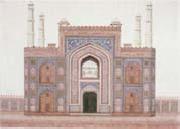 |
Mather Brown
|
|
American Painter, 1761-1831
was a portrait and historical painter, born in Boston, Massachusetts but active in England. Brown was the son of Gawen and Elizabeth (Byles) Brown, and descended from the Rev. Increase Mather on his mother's side. He was taught by his aunt and around 1773 (age 12) became a pupil of Gilbert Stuart. He arrived in London in 1781 to further his training in Benjamin West's studio, entered the Royal Academy schools in 1782 with plans to be a miniature painter, and began to exhibit a year later. In 1784 he painted two religious paintings for the church of St Mary??s-in-the-Strand, which led Brown to found a partnership with the painter Daniel Orme for the commercialization of these and other works through exhibition and the sale of engravings. Among these were large paintings of scenes from English history, as well as scenes from Shakespeare's plays. However, despite their success he began to concentrate on portraiture. His first successes were with American sitters, among others his patron John Adams and family in 1784?C85; this painting is now in the Boston Athenaeum. In 1785?C86 he painted the first portrait of Thomas Jefferson, who was visiting London. He also painted Sir William Pepperrell. His 1788 full-length portrait of Prince Frederick Augustus in the uniform of Colonel of the Coldstream Guards led to appointment as History and Portrait Painter to the Prince, later the Duke of York and Albany. Other paintings include the Prince of Wales, later George IV (about 1789), Queen Charlotte, and Cornwallis. A self-portrait now belongs to the American Antiquarian Society, Worcester, Massachusetts. A falling off of patronage in the mid-1790s, and failure to be elected to the Royal Academy, led Brown to leave London in 1808 for Bath, Bristol, and Liverpool.
|
|
|
|
|
|
|
|
|
|
|
|
|
|
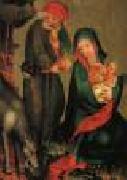 |
MASTER Bertram
|
|
German painter (b. cca. 1345, Minden, d. 1415, Hamburg).
was a German International Gothic painter primarily of religious art. His most famous surviving work is the large Grabow Altarpiece (or Petri-Altar) in the Kunsthalle Hamburg, the largest and most important North German painting of the period. There is a 45-scene altarpiece of the Apocalypse, probably by his workshop, in the Victoria and Albert Museum in London. He, or his workshop, also produced sculpture, presumably in wood; in fact in his first years in Hamburg most surviving documentation relates to sculpture, including chandeliers. He is first recorded in Hamburg in 1367, and lived there for the rest of his life, becoming a citizen and Master in 1376, and achieving considerable prosperity. In 1390 he made a will in advance of an intended pilgrimage to Rome, but if he made the journey it had no detectable influence on his art. He was married, but his wife had died by his second will in 1410, when he had a surviving daughter. His style is less emotional than that of his Hamburg near-contemporary Master Francke, but has great charm. Bertram was largely forgotten after the Renaissance until the end of the 19th century
|
|
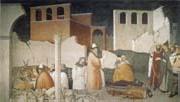 |
Maso di Banco
|
|
Italian Early Renaissance Painter, active 1320-1350
|
|
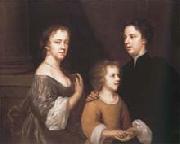 |
Mary Beale
|
|
English Baroque Era Painter, 1633-1699
was an English portrait painter. She became one of the most important portrait painters of 17th century England, and has been described as the first professional female English painter. Beale was born in Barrow, Suffolk, the daughter of John Cradock, a Puritan rector. Her mother, Dorothy, died when she was 10. She married Charles Beale, a cloth merchant from London, in 1652, at the age of 18. Her father and her husband were both amateur painters, her father being a member of the Painter-Stainers' Company, and she was acquainted with local local artists, such as Nathaniel Thach, Matthew Snelling, Robert Walker and Peter Lely. She became a semi-professional portrait painter in the 1650s and 1660s, working from her home, first in Covent Garden and later in Fleet Street. The family moved to a farmhouse in Allbrook, Hampshire in 1665 due to financial difficulties, her husband having lost his position as a clerk of patents, and also due to the Great Plague in London. For the next five years, a 17th-century two storey timber-framed building was her family home and studio. She returned to London in 1670, where she established a studio in Pall Mall, with her husband working as her assistant, mixing her paints and keeping her accounts. She became successful, and her circle of friends included Thomas Flatman, poet Samuel Woodford, Archbishop of Canterbury John Tillotson, and Bishops Edward Stillingfleet and Gilbert Burnet. She became reacquainted with Peter Lely, now Court Artist to Charles II. Her later work is heavily influenced by Lely, being mainly small portraits or copies of Lely's work. Her work became unfashionable after his death in 1680.
|
|
|
|
|
|
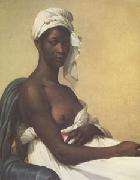 |
Marie-Guillemine Benoist
|
|
Paris 1768-1826
was a French neoclassical, historical and genre painter. She was born in Paris, the daughter of a civil servant. Her training as an artist began in 1781 under Élisabeth Vigee Le Brun, and she entered Jacques-Louis David's atelier in 1786 along with her sister Marie-Élisabeth Laville-Leroux. The poet Charles-Albert Demoustier, who met her in 1784, was inspired by her in creating the character Émile in his work Lettres Émilie sur la mythologie (1801). In 1791 she exhibited for the first time in the Salon de Paris, displaying her mythology-inspired picture Psych faisant ses adieux sa famille. Another of her paintings of this period, L'Innocence entre la vertu et le vice, is similarly mythological and reveals her feminist interests in this picture, vice is represented by a man, although it was traditionally represented by a woman. In 1793, she married the lawyer Pierre-Vincent Benoist. Her work, reflecting the influence of Jacques-Louis David, tended increasingly toward history painting by 1795. In 1800, she exhibited Portrait d'une negresse in the Salon. Six years previously, slavery had been abolished, and this image became a symbol for women's emancipation and black people's rights. This picture was acquired by Louis XVIII for France in 1818. An important commission, for a full-length portrait of Napol on Bonaparte Premier Consul Français in this period was awarded to her in 1803. This portrait was to be sent to the city of Ghent, newly ceded to France by the Treaty of Luneville in 1801. Other honors came to her; she was awarded a Gold Medal in the Salon of 1804, and received a governmental allowance. During this time she opened an atelier for the artistic training of women. Her career was harmed by political developments, however, when her husband, the convinced royalist count Benoist, was nominated in the Conseil d'État during the post-1814 monarchy come-back called the Bourbon Restoration.
|
|
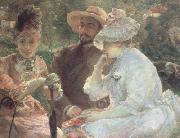 |
Marie Bracquemond
|
|
French Impressionist Painter, 1840-1916
.was a French Impressionist artist described by Gustave Geffroy in 1894 as one of the "le trois grandes dames" of Impressionism alongside Berthe Morisot and Mary Cassatt.However, her often omission from books on women artists indicate the success of her husband, F??lix Bracquemond, in his campaign to thwart her development as an artist.
|
|
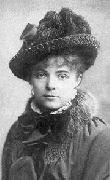 |
Marie Bashkirtseff
|
|
(Russian: November 11, 1858 October 31, 1884) was a Ukrainian-born Russian diarist, painter and sculptor.
Marie BashkirtseffBorn Maria Konstantinovna Bashkirtseva in Gavrontsy near Poltava, to a wealthy noble family, she grew up abroad, traveling with her mother across most of Europe. Educated privately, she studied painting in France at the Acad??mie Julian, one of the few establishments that accepted female students. The Acad??mie attracted young women from all over Europe and the United States. One fellow student was Louise Breslau who Marie viewed as her only rival. Marie would go on to produce a remarkable body of work in her short lifetime, the most famous being the portrait of Paris slum children titled The Meeting and In the Studio, (shown here) a portrait of her fellow artists at work. Unfortunately, a large number of Bashkirtseff's works were destroyed by the Nazis during World War II.
From the age of 13, she began keeping a journal, and it is for this she is most famous. Her personal account of the struggles of women artists is documented in her published journals, which are a revealing story of the bourgeoisie. Titled, I Am the Most Interesting Book of All, her popular diary is still in print today. The diary was cited by an American contemporary, Mary MacLane, whose own shockingly confessional diary drew inspiration from Bashkirtseff's. Her letters, consisting of her correspondence with the writer Guy de Maupassant, were published in 1891.
The grave of Marie BashkirtseffDying of tuberculosis at the age of 25, Bashkirtseff lived just long enough to become an intellectual powerhouse in Paris in the 1880s. A feminist, in 1881, using the nom de plume "Pauline Orrel," she wrote several articles for Hubertine Auclert's feminist newspaper, La Citoyenne. One of her famous quotes is: Let us love dogs, let us love only dogs! Men and cats are unworthy creatures.
|
|
 |
Marcello Bacciarelli
|
|
16 February 1731 - 5 January 1818) was an Italian painter of the late-baroque and Neoclassic periods.
He studied in Rome under Marco Benefial. In 1750 he was called to Dresden, Saxony, where he was employed by Elected King Augustus III of Poland; after whose death he went to Vienna, and thence to Warsaw. There he met and worked by the side of Italian painter in Dresden, Vienna and Warszawa , Bernardo Bellotto. He was the Director there of the new set up Academy of Arts of Warsaw.He painted a set of the Polish kings, from Boleslaus Chrobry downwards. That of Stanislaus II, Stanisław August Poniatowski has been engraved by A. de Marcenay de Ghuy, Kestner, and A. Fogg. Bacciarelli also painted scenes from the History of Poland. He died at Warsaw.
A number of his paintings were painted for King Stanisław August Poniatowski of Poland and are in the Royal Castle in Warsaw.
|
|
|
|
|
|
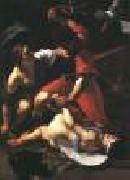 |
MANFREDI, Bartolomeo
|
|
Italian Baroque Era Painter, 1582-1622
Italian painter. In the 17th century he was known throughout Italy and beyond as Caravaggio's closest follower and his works were highly prized and widely collected. More than simply aping Caravaggio's style, Manfredi reinterpreted his subjects and rendered new ones, drawing upon Caravaggio's naturalism and dramatic use of chiaroscuro. His paintings were often praised by his contemporaries as equal to Caravaggio's and he was subsequently emulated and imitated by other Roman Caravaggisti during the 1610s and 1620s. Yet by the 18th century his works were forgotten or confused with those of Caravaggio himself,
|
|
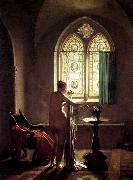 |
MALLET, Jean-Baptiste
|
|
French Painter, 1759-1835,French painter. A pupil of Simon Julien in Toulon, he was then taught by Pierre-Paul Prud'hon in Paris. He exhibited at every Salon between 1793 and 1827, obtaining a second class medal in 1812 and a first class medal in 1817. He executed very few portraits (Chenier, Carcassonne, Mus. B.-A., is an exception), preferring to paint nymphs bathing and graceful classical nudes such as the Graces Playing with Cupid (Arras, Abbaye St Vaast, Mus. B.-A.). He established his reputation with gouache genre scenes of fashionable and often libertine subjects, always elegant and refined, in the style of Louis-Philibert Debucourt and Louis-Leopold Boilly, and remarkable for the delicacy and brilliance of their brushwork: for example At the Laundry Maid's and the Painful Letter (both Paris, Mus. Cognacq-Jay). They reveal a knowledge of 17th-century Dutch painting in the treatment of details (transparent crystal, reflections on silk or satin) as well as the choice of themes: Military Gallant (Paris, Mus. Cognacq-Jay). Mallet's meticulously precise paintings are one of the best records of fashionable French furnishings and interiors at the end of the 18th century and the beginning of the 19th.
|
|
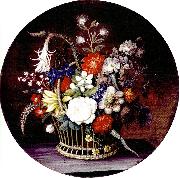 |
magdalene margrethe barens
|
|
Magdalene Margrethe Bärens, född 1737, död 1808, var en dansk konstnär; hon blev den första kvinnliga konstnären i Danmark som valdes in i den danska konstakademin år 1780.
Hon var en av de få kvinnliga konstnärerna kända i Skandinavien före 1800-talet, tillsammans med Ulrika Pasch i Sverige och Helena Arnell i Finland. I Danmark var även Johanne Marie Fosie känd under samma tid.
|
|
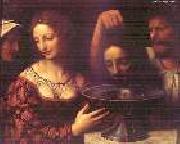 |
LUINI, Bernardino
|
|
Italian High Renaissance Painter, ca.1480-1532
Italian painter and draughtsman. He was one of the generation of Lombard painters active around 1500 who, influenced by Leonardo and Raphael, blended High Renaissance innovations with indigenous Milanese elements to create a Lombard Renaissance style. Luini's paintings were extremely popular with both collectors and critics from c. 1790 to the end of the 19th century. This widespread popularity, however, had unfortunate consequences: many of his frescoes were detached from their original settings, many of the panel paintings were transferred to canvas and other works were heavily restored. As a result few survive in a good state. About 700 works are attributed to Luini, but many of these attributions are over optimistic.
|
|
 |
ludwig van beethoven
|
|
Born: December 1770
Birthplace: Bonn, Germany
Died: 26 March 1827 (cirrhosis of the liver, plus dropsy)
Best Known As: The composer of Beethoven's Fifth
|
|
|
|
|
|
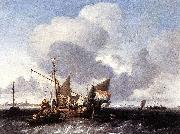 |
Ludolf Bakhuizen
|
|
(December 28, 1630 - November 17, 1708) was a German-born Dutch Golden Age painter who was the leading Dutch painter of maritime subjects after the two Willem van de Veldes (father and son) left for England in 1672.
He was born in Emden, East Frisia, and came to Amsterdam in about 1650, working as a merchant's clerk and a calligrapher. He discovered so strong a genius for painting that he relinquished the business and devoted himself to art from the late 1650s, initially in pen drawings. He studied first under Allart van Everdingen and then under Hendrik Dubbels, two eminent masters of the time, and soon became celebrated for his sea-pieces, which often had rough seas.
He was an ardent student of nature, and frequently exposed himself on the sea in an open boat in order to study the effects of storms. His compositions, which are numerous, are nearly all variations of one subject, the sea, and in a style peculiarly his own, marked by intense realism or faithful imitation of nature. In his later years Bakhuizen employed his skills in etching; he also painted a few examples each of several other genres of painting, such as portraits, landscapes and genre paintings.
|
|
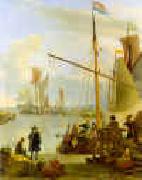 |
Ludolf Backhuysen
|
|
b.Dec. 18, 1631, Emden, East Frisia [Germany]
d.Nov. 17, 1708, Amsterdam, Neth.
Dutch
Ludolf Backhuysen Gallery
|
|
|
|
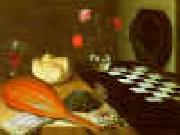 |
Lubin Baugin
|
|
1610-1663
French
Lubin Baugin Gallery
French painter. He became a master in the painters guild of Saint-Germain-des-Pras in 1629. From c. 1636 he was in Italy, but he is known to have been in Paris again in 1641; in 1645 he became a member of the Acadmie de St Luc, and in 1651 he was also a member of the Acadmie Royale after the temporary amalgamation of the two institutions. Like many of his generation he was deeply influenced by the art of the Fontainebleau school.
|
|
 |
Louise-Catherine Breslau
|
|
(6 December 1856 - 12 May 1927) was a German/Swiss artist.
Born Maria Luise Katharina Breslau in Munich, Germany, she spent her childhood in Zurich, Switzerland and as an adult made Paris, France her home. Suffering from asthma all her life, Breslau turned to drawing as a child to help pass the time while confined to her bed. Although she became one of the most sought after portraitists of her time, after her death she and her work were all but forgotten. It has only been in the past few years that interest in Breslau and her works has been growing.
Breslau was born into a prosperous bourgeois family; her father was a well-respected physician specializing in obstetrics and gynecology. When Breslau was two years old, her father accepted the position of professor and head physician of Obstetrics and Gynecology at the University of Zurich; Switzerland became home to the Breslau family.
|
|
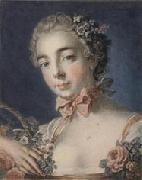 |
Louis-Marin Bonnet
|
|
French, 1736 - 1793
French engraver and publisher. He came from a family of artisans and owed his training in engraving to his brother-in-law, the engraver Louis Legrand (1723-1808). Through Legrand, Bonnet became the pupil of Jean-Charles Francois in 1756, a year before the latter discovered the CRAYON MANNER technique of engraving, designed to reproduce the effect of a coloured-chalk drawing. Around the end of 1757 Bonnet used the new technique to engrave a Cupid after Francois Eisen. Gilles Demarteau, a rival of Jean-Charles Francois
|
|
|
|
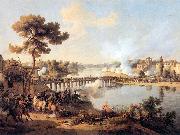 |
Louis-Francois, Baron Lejeune
|
|
(3 February 1775, Strasbourg - 29 February 1848) was a French general, painter, and lithographer. His memoirs have frequently been republished and his name is engraved on the Arc de Triomphe.
He studied painting in the studio of Pierre-Henri de Valenciennes, alongside Jean-Victor Bertin, but left the studio to volunteer in the Compagnie des arts de Paris in 1792. He received his baptism of fire in the battle of Valmy later that year. He became a sergeant in the 1st Arsenal battalion and in 1793 moved to the artillery at La Fere, assisting in the sieges of Landrecies, Le Quesnoy and Valenciennes. At Valenciennes he became aide-de-camp to general Jacob then, as a lieutenant on attachment to the engineers, took part in the 1794 Holland campaign and the 1795 campaign.
Called to the depot in 1798, he succeeded brilliantly in his exams and was made a captain on attachment to the engineers. He became aide-de-camp to marshal Berthier in 1800, a post he retained until 1812 and in which he took an active part in practically all of the Napoleonic campaigns. He was wounded and captured in Spain. He was promoted to full captain after Marengo and chef de bataillon after Austerlitz, also become a knight of the Legion d'honneur and a colonel at the Siege of Saragossa.
The German campaign of 1806 brought him to Munich, where he visited the workshop of Alois Senefelder, the inventor of lithography. Lejeune was fascinated by the possibilities of the new method and whilst there he made the drawing on stone of his famous Cossack (printed by C. and ~f. Senefelder, 1806). Whilst he was taking his dinner, and with his horses harnessed and waiting to take him back to Paris, one hundred proofs were printed, one of which he subsequently submitted to Napoleon. The introduction of lithography into France was greatly due to the efforts of Lejeune.
In 1812, during the French invasion of Russia, he was made general de brigade and chief of staff to Davout. Frostbitten on the face, Lejeune left his post during the retreat from Russia and was arrested on the orders of Napoleon. Freed in March 1813, Lejeune was then sent to the Illyrian provinces, before rejoining the army under the orders of marshal Oudinot, becoming his chief of staff. During the Saxony campaign, Lejeune was present at the Battle of Lutzen (1813), the crossing of the River Spree and at Bautzen. He was made an officer of the Legion d'honneur and a commander of the Order of Maximilian of Bavaria. At the battle of Hoyersverda, when Below's corps wiped out the 12th corps formed up in square on the plain, Lejeune (at risk of being kidnapped) ventured into the enemy lines with one battalion, general Wolf's cavalry and six 12 pounder guns. He thus broke the whole of the Prussian artillery and saved marshal Oudinot and his army. Wounded several times and lastly at Hanau, he was authorised to leave the army in November 1813 after more than 20 years' service. After his departure from the army, he devoted himself to painting.
|
|
|
|
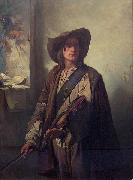 |
Louis Gallait
|
|
(9 or 10 May 1810 - 20 November 1887) was a Belgian painter. His d his reputation especially with the large painting of Charles V's abdication. Gallait's works were considered as the basis for a desirable renewal of historical paintings because of the realism, costume faithfulness and colorful posture of his paintings. His last artwork was sent on tour in Germany and that led to new signals even among German historians. He was also a distinguished portrait painter.
Gallait died in Brussels in 1887. There is a painting by Louis Gallait at the Norton Art Museum in West Palm Beach, Florida ("Art and Liberty").
|
|
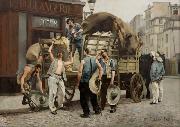 |
Louis Carrier-Belleuse
|
|
(1848-1913) was a French painter and sculptor.
He was son and pupil of Albert-Ernest Carrier-Belleuse. He designed the patterns of the Faïencerie (earthenware factory) from Choisy-le-Roi, where he was artistic director. He was also the sculptor of the Equestrian monument to General Manuel Belgrano
|
|
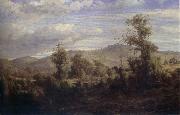 |
Louis Buvelot
|
|
Swiss-born Australian Painter
1814-1888
was a Swiss-born landscape painter who emigrated to Australia in 1865 and influenced the Heidelberg School of painters. Buvelot was born in Morges, Vaud, Switzerland, second son of Francois Simeon Buvelot, postal official, and his wife Jeanne-Louise nee Heizer, a school teacher. Louis Buvelot worked under Marc-Louis Arland at Lausanne, and from around 1834 continued his studies at Paris with Camille Flers, a well-known landscape painter of the day. After a few months there he migrated to Bahia, Brazil where he worked on his uncle's coffee plantation. In October 1840 Buvelot moved to Rio de Janeiro and attracted the notice of the emperor Dom Pedro II, who bought some of his pictures and decorated him with the Order of the Rose. In November 1843 Buvelot married Marie-Felicite, nee Lalouette (born 1816). Buvelot returned to Switzerland in 1852 and in 1856 was awarded a silver medal for a picture exhibited at Berne.
|
|
|
|
|
|
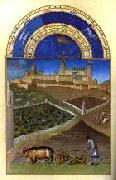 |
LIMBOURG brothers
|
|
Flemish painters (b. 1370-80, Nijmegen, d.
1416, Nijmegen).
family of Franco-Flemish manuscript illuminators. The Limbourg brothers, Pol, Jan, and Herman, were trained as goldsmiths. They succeeded Jacquemart de Hesdin in 1411 as court painters to Jean, duc de Berry. Their masterpiece is the magnificent book of hours known as the Tr??s Riches Heures (c.1415; Mus??e Cond??, Chantilly). This is filled with exquisite illustrations of the daily life of the aristocracy and peasantry, including a series of calendar illuminations that are considered the finest extant examples of the International Gothic style
|
|
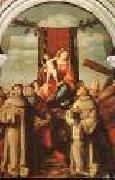 |
LICINIO, Bernardino
|
|
Italian painter, Venetian school (b. ca. 1489, Poscante, d. ca. 1565, Venezia)
|
|
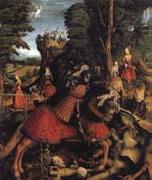 |
Leonhard Beck
|
|
German Northern Renaissance Painter, ca.1480-1542, Illuminator, painter, draughtsman and woodcutter, son of Georg Beck. He first appears as an illuminator and collaborator with his father in two Psalters for the Augsburg monastery of SS Ulrich and Afra in 1495, producing 35 coloured initial letters for each of them (Augsburg, Staats- & Stadtbib., Cod. 49a). These are vigorously coloured but fairly uniform in character, with small, lively biblical scenes excellently adapted to the letters. Red, green and blue predominate; ochre tones provide a link with the gold ground. The initial letter X is composed of splendidly curled, entwining foliage with birds and half-figures of prophets; the Virgin, Joseph, the Christ Child in the manger and the choir of angels are each enclosed in one of its sectors. The figures are presented in a light, easy manner; the draughtsmanship avoids unnecessary detail.
|
|
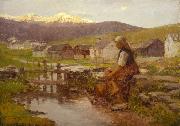 |
Leonardo Bazzaro
|
|
(Milan, 1853-1937) was an Italian painter.
After picking up the basics in the studio of the painter Gaetano Fasanotti, Bazzaro enrolled at the Brera Academy in Milan, where he was awarded the Fumagalli Prize in 1875. The following years saw a series of perspective views set in Milanese churches and mansions. The success achieved with the public and critics alike at a number of major national and international events prompted him to take an interest also in portraiture and landscape painting, for which his favourite settings were Venice and Chioggia. The works of the 1880s and 1890s also include increasingly intimist scenes of everyday life in the setting of Valsassina, Valle deAosta and Verbano. Bazzaro continued to take part in numerous exhibitions in the region of Lombardy as well as the Venice Biennale and the Rome Quadrenniale right up to his death, always achieving great success with collectors and being asked to execute replicas of his most popular subjects.
|
|
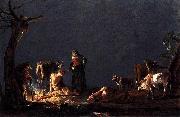 |
Leonaert Bramer
|
|
(24 December 1596 - 10 February 1674 (buried)) was a Dutch painter, best known for probably being one of the teachers of Johannes Vermeer, although there is no similarity between their work. Bramer's dark and exotic style is unlike Vermeer's style. Bramer was primarily a genre and history painter, but also made some unique frescos, not very often found north of the Alps. Leonaert Bramer is one of the most intriguing personalities in seventeenth-century Dutch art. He was a talented and diligent draughtsman, evidently Roman Catholic and a lifelong bachelor.
Bramer was born in Delft. In 1614, at the age of 18, he left on a long trip eventually reaching Rome in 1616, via Atrecht, Amiens, Paris, Aix (February 1616), Marseille, Genoa, and Livorno. In Rome he was one of the founders of the Bentvueghels group of Northern artists. He lived with Wouter Crabeth and got into a fight with Claude Lorraine. He dedicated a poem to Wybrand de Geest. Bramer remained on and off in Rome until October 1627, visiting Mantua and Venice, often for deliveries and to meet Domenico Fetti. In Italy Bramer was nicknamed Leonardo della Notte ("Leonardo of the night"). In 1648 he went to Rome for a second time.
By 1628 he was back in Delft, where he joined the Guild of Saint Luke in 1629 and the schutterij. Among his many patrons were members of the House of Orange, but local burgomasters and schepen also bought his paintings in great numbers.[3] He was a many sided artist, designing for tapestry firms in Delft, painting murals and ceilings, some of which are illusionistic in style. He painted real frescos in the Civic Guard house, the nearby stadholder's palaces in Honselersdijk, Rijswijk, the Communal Land Housde and the Prinsenhof in Delft.[3] Due to the Dutch climate they no longer survive.
He evidently knew the greatest of his Delft contemporaries, Johannes Vermeer, as he came to the latter's defence when his future mother-in-law was trying to prevent him from marrying her daughter.
|
|
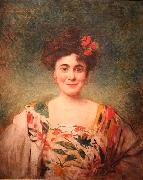 |
Leon Joseph Florentin Bonnat
|
|
(20 June 1833 - 8 September 1922) was a French painter.
He was born in Bayonne, but from 1846 to 1853 he lived in Madrid, where his father owned a bookshop. While tending his father's shop, he copied engravings of works by the Old Masters, developing a passion for drawing. In Madrid he received his artistic training under Madrazo. He later worked in Paris, where he became known as a leading portraitist, never without a commission. His many portraits show the influence of Velezquez, Jusepe de Ribera and other Spanish masters, as well as Titian and Van Dyke, whose works he studied in the Prado. Following the period in Spain Bonnat worked the ateliers of the history painters Paul Delaroche and Leon Cogniet (1854) in Paris. Despite repeated attempts, he failed to win the prix de Rome, finally receiving only a second prize. However, a scholarship from his native Bayonne allowed him to spend three years in Rome (1858 - 60) independently. During his stay in Rome, he became friends with Edgar Degas, Gustave Moreau, Jean-Jacques Henner and the sculptor Henri Chapu.
He won a medal of honor in Paris in 1869, going on to become one of the leading artists of his day. Bonnat went on to win the Grand Officer of the Legion d'honneur and became a professor at the Ecole des Beaux Arts in 1882. Bonnat was quite popular with American students in Paris. In addition to his native French, he spoke Spanish and Italian and knew English well, to the relief of many monolingual Americans. In May 1905 he succeeded Paul Dubois as director of the Ecole des Beaux-Arts. Bonnat "was a liberal teacher who stressed simplicity in art above high academic finish, as well as overall effect rather than detail," explains Julius Kaplan (see References). Bonnat's emphasis on overall effect on the one hand, and rigorous drawing on the other, put him in a middle position with respect to the Impressionists and academic painters like his friend Jean-Leon Gerôme.
|
|
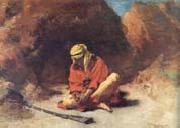 |
Leon Bonnat
|
|
French Academic Painter, 1833-1922,was a French painter. He was born in Bayonne, but from 1846 to 1853 he lived in Madrid, Spain, where his father owned a bookshop. In Madrid he received his artistic training under Madrazo. He later worked in Paris, where he became known as a leading portraitist. His many portraits show the influence of Velazquez and the Spanish realists. He won a medal of honor at Paris in 1869, where he became one of the leading artists of his day. Bonnat went on to become a professor at the Ecole des Beaux Arts in 1882. In May 1905 he succeeded Paul Dubois as director. His vivid portrait-painting is his most characteristic work, but his subject pictures, such as the Martyrdom of St Denis in the Pantheon, are also famous. Some of Bonnat's more notable students include: Gustave Caillebotte, Suzor-Cote, Georges Braque,Raoul Dufy, Marius Vasselon, Fred Barnard,
|
|
 |
Leon Benouville
|
|
Paris 1821 - Paris 1859.
was a French painter. Leon Benouville first studied with his elder brother Jean-Achille Benouville (1815-1891) in the studio of François-Edouard Picot before he transferred to Ecole des Beaux-Arts in 1837. Like his brother he received the Prix de Rome in 1845. In Rome, as a Prix de Rome pensionary at the Villa Medici, he stayed with his brother and met the sculptor Charles Gumery.
|
|
|
|
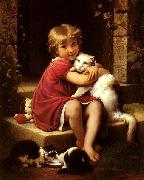 |
Leon Bazille Perrault
|
|
(20 June 1832, Poitiers - 1908, Royan) was a French painter.
A student of William Bouguereau and François-Edouard Picot, he exhibited at the Salon from 1863 onwards, producing several works, in the academic tradition. He was famous for his le petit naufrag (The little shipwrecked boy, 1874) and his paintings of children.
|
|
|
|
|
|
|
|
|
| Wholesale China Oil Painting Wholesale Oil Painting China Xiamen Portrait Reproduction on canvas Chinese Oil Painting Wholesale USA Oil Painting |
|
|
|
|
|